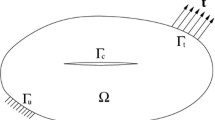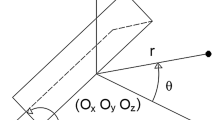Abstract
Different fracture methods in meshfree methods are studied and compared. Our studies focuses on the elementfree Galerkin (EFG) method though similar results were obtained with SPH and MPM. Three major fracture approaches are tested: Natural fracture, smeared crack method and discrete crack method. In the latter method, the crack is represented as continuous line and as set of discrete crack segment. Natural fracture is a key feature of meshfree methods. In some numerical examples, we will show that natural fracture criterion cannot handle even simple fracture adequately. Moreover, we will show in our numerical examples that smeared crack models can capture global behavior appropriately for simple examples but not for complex examples involving branching cracks. The most accurate methods are discrete fracture methods.
Similar content being viewed by others
References
Lucy L (1977) A numerical approach to the testing of the fission hypothesis. Astron J 82:1013–1024
Sulsky D, Chen Z, Schreyer HL (1994) A particle method for history-dependent materials. Comput Methods Appl Mech Eng 118:179–196
Belytschko T, Lu YY, Gu L (1994) Element-free Galerkin methods. Int J Numer Methods Eng 37:229–256
Liu WK, Jun S, Zhang YF (1995) Reproducing kernel particle methods. Int J Numer Methods Eng 20:1081–1106
Randles PW, Libersky L (2000) Normalized sph with stress points. Int J Numer Methods Eng 48:1445–1461
Randles PW, Libersky LD (1996) Smoothed particle hydrodynamics: some recent improvements and applications. Comput Methods Appl Mech Eng 139:375–408
Randles PW, Libersky LD (1997) Recent improvements in sph modeling of hypervelocity impact. Int J Impact Eng 20:525–532
Randles PW, Carney TC, Libersky LD (1995) Sph simulation of fragmentation in the mk82 bomb. Shock Compress Condens Matter 370:331–334
Randles PW, Carney TC, Libersky LD (1995) Calculation of oblique impact and fracture of tungsten cubes using smoothed particle hydrodynamics. Int J Impact Eng 17:661–672
Rabczuk T, Eibl J (2003) Simulation of high velocity concrete fragmentation using sph/mlsph. Int J Numer Methods Eng 56:1421–1444
Rabczuk T, Belytschko T (2005) Adaptivity for structured meshfree particle methods in 2d and 3d. Int J Numer Methods Eng 63(11):1559–1582
Rabczuk T (2006) Modelling dynamic failure of concrete with meshfree methods. Int J Impact Eng 32(11):1878–1897
Rabczuk T, Belytschko T, Xiao SP (2004) Stable particle methods based on Lagrangian kernels. Comput Methods Appl Mech Eng 193:1035–1063
Vignjevic R, Reveles JR, Campbell J (2006) Sph in a total Lagrangian formalism. Comput Model Eng Sci 14(3):181–198
Belytschko T, Guo Y, Liu WK, Xiao SP (2000) A unified stability analysis of meshfree particle methods. Int J Numer Methods Eng 48:1359–1400
Belytschko T, Lu YY (1995) Element-free Galerkin methods for static and dynamic fracture. Int J Solids Struct 32:2547–2570
Belytschko T, Lu YY, Gu L (1995) Crack propagation by element-free Galerkin methods. Eng Fract Mech 51(2):295–315
Belytschko T, Tabbara M (1996) Dynamic fracture using element-free Galerkin methods. Int J Numer Methods Eng 39(6):923–938
Belytschko T, Krongauz Y, Organ D, Fleming M, Krysl P (1996) Meshless methods: an overview and recent developments. Comput Methods Appl Mech Eng 139:3–47
Hao S, Liu WK, Klein PA, Rosakis AJ (2004) Modeling and simulation of intersonic crack growth. Int J Solids Struct 41(7):1773–1799
Krysl P, Belytschko T (1999) The efgm for dynamic propagation of arbitrary three-dimensional cracks. Int J Numer Methods Eng 44(6):767–800
Belytschko T, Chen H, Xu J, Zi G (2001) Dynamic crack propagation based on loss of hyperbolicity and a new discontinuous enrichment. Int J Numer Methods Eng 58(12):1873–1905
Song J-H, Areais PMA, Belytschko T (2006) A method for dynamic crack and shear band propagation with phantom nodes. Int J Numer Methods Eng 67:868–893
Rabczuk T, Gracie R, Song J-H, Belytschko T (2010) Immersed particle method for fluid-structure interaction. Int J Numer Methods Eng 81:48–71
Ventura G, Xu J, Belytschko T (2002) A vector level set method and new discontinuity approximation for crack growth by efg. Int J Numer Methods Eng 54(6):923–944
Fleming M, Chu YA, Moran B, Belytschko T (1997) Enriched element-free Galerkin methods for crack tip fields. Int J Numer Methods Eng 40:1483–1504
Belytschko T, Fleming M (1999) Smoothing, enrichment and contact in the element free Galerkin method. Comput Struct 71:173–195
Zi G, Rabczuk T, Wall W (2007) Extended meshfree methods without branch enrichment for cohesive cracks. Comput Mech 40(2):367–382
Rabczuk T, Belytschko T (2006) Application of particle methods to static fracture of reinforced concrete structures. Int J Fract 137(14):19–49
Rabczuk T, Areias P (2006) A meshfree thin shell for arbitrary evolving cracks based on an extrinsic basis. Comput Model Eng Sci 16(2):115–130
Rabczuk T, Bordas S, Zi G (2007) A three dimensional meshfree method for static and dynamic multiple crack nucleation/propagation with crack path continuity. Comput Mech 40(3):473–495
Rabczuk T, Areias PMA, Belytschko T (2007) A simplified meshfree method for shear bands with cohesive surfaces. Int J Numer Methods Eng 69:993–1021
Rabczuk T, Areias PMA, Belytschko T (2007) A meshfree thin shell method for non-linear dynamic fracture. Int J Numer Methods Eng 72(5):524–548
Rabczuk T, Belytschko T (2007) A three-dimensional large deformation meshfree method for arbitrary evolving cracks. Comput Methods Appl Mech Eng 196(2930):2777–2799
Rabczuk T, Zi G, Bordas S, Nguyen-Xuan H (2008) A geometrically non-linear three-dimensional cohesive crack method for reinforced concrete structures. Eng Fract Mech 75:4740–4758
Nguyen VP, Rabczuk T, Bordas S, Duflot M (2008) Meshless methods: a review and computer implementation aspects. Math Comput Simul 79:763–813
Rabczuk T, Belytschko T (2004) Cracking particles: a simplified meshfree method for arbitrary evolving cracks. Int J Numer Methods Eng 61(13):2316–2343
Beissel S, Belytschko T (1996) Nodal integration in the elementfree Galerking method. Comput Methods Appl Mech Eng 138:49–74
Vignjevic R, Reveles JR, Campbell J (2006) Sph in a total Lagrangian formalism. Comput Model Eng Sci 14:181–198
Feldman J, Bonet J (2007) Dynamic refinement and boundary contact forces in sph with applications in fluid flow problems. Int J Numer Methods Eng 72(3):295–324
Dyka CT, Ingel RP (1995) An approach for tensile instability in SPH. Comput Struct 57:573–580
Bazant ZP, Belytschko T (1985) Wave propagation in a strain softening bar: exact solution. J Eng Mech ASCE 11:381–389
Bazant ZP, Oh BH (1983) Crack band theory for fracture in concrete. Mater Struct 16:155–177
Sun Y, Hu YG, Liew KM (2007) A mesh-free simulation of cracking and failure using the cohesive segments method. Int J Eng Sci 45:541–553
Wang HX, Wang SX (2008) Analysis of dynamic fracture with cohesive crack segment method. Comput Model Eng Sci 35(3):253–274
Arrea M, Ingraffea AR Mixed-mode crack propagation in mortar and concrete. Technical report 81-13, Department of Structural Engineering, Cornell University New York, 1982
Xu X-P, Needleman A (1994) Numerical simulations of fast crack growth in brittle solids. J Mech Phys Solids 42:1397–1434
Zhang YY, Chen L (2008) A simplified meshless method for dynamic crack growth. Comput Model Eng Sci 31:189–199
Rabczuk T, Zi G (2007) A meshfree method based on the local partition of unity for cohesive cracks. Comput Mech 39(6):743–760
Sharon E, Gross PSP, Fineberg J (1995) Local crack branching as a mechanism for instability in dynamic fracture. Phys Rev Lett 74:5096–5099
Ravi-Chandar K (1998) Dynamic fracture of nominally brittle materials. Int J Fract 90:83–102
Rabczuk T, Belytschko T (2007) A three dimensional large deformation meshfree method for arbitrary evolving cracks. Comput Methods Appl Mech Eng 196:2777–2799
Kalthoff JF, Winkler S (1987) Failure mode transition at high rates of shear loading. Int Conf Impact Load Dyn Behav Mater 1:185–195
Rabczuk T, Zi G, Gerstenberger A, Wall WA (2008) A new crack tip element for the phantom node method with arbitrary cohesive cracks. Int J Numer Methods Eng 75:577–599
Ravi-Chandar K, Lu J, Yang B, Zhu Z (2000) Failure modes transitions in polymers under high strain rate loading. Int J Fract 101:33–72
Rabczuk T, Zi G, Bordas S, Nguyen-Xuan H (2010) A simple and robust three-dimensional cracking-particle method without enrichment. Comput Methods Appl Mech Eng 199:2437–2455
Batra RC, Gummalla RR (2000) Effect on material and geometric parameters on deformations near the notch-tip of a dynamically loaded prenotched plate. Int J Fract 101(99–140)
Batra RC, Ravisankar MVS (2000) Three-dimensional numerical simulation of the Kalthoff experiment. Int J Fract 105(161–186)
Zhou M, Ravichandran G, Rosakis A (1996) Dynamically propagating shear bands in impact-loaded prenotched plates—I. J Mech Phys Solids 44:981–1006
Zhou M, Ravichandran G, Rosakis A (2000) Dynamically propagating shear bands in impact-loaded prenotched plates—II. J Mech Phys Solids 44 (1007–1032)
Rabczuk T, Samaniego E (2008) Discontinuous modelling of shear bands using adaptive meshfree methods. Comput Methods Appl Mech Eng 197:641–658
Rabczuk T, Song J-H, Belytschko T (2009) Simulations of instability in dynamic fracture by the cracking particles method. Eng Fract Mech 76:730–741
Author information
Authors and Affiliations
Corresponding author
Rights and permissions
About this article
Cite this article
Rajagopal, S., Gupta, N. Meshfree modelling of fracture—a comparative study of different methods. Meccanica 46, 1145–1158 (2011). https://doi.org/10.1007/s11012-010-9367-z
Received:
Accepted:
Published:
Issue Date:
DOI: https://doi.org/10.1007/s11012-010-9367-z




